Menu

It’s estimated that more than 8 billion people lived on Earth by November 2022, and this number may hit 10 billion by 2050. Our growing population is putting heavy demands on the planet, especially in farming. Agriculture is a major source of greenhouse gases, using a lot of energy, and causing much deforestation. Plastics are a big part of this industry, with about 12.5 million tons used every year for the last 70 years. A large part of this is plastic mulch films, making up half of the total.
The rising use of plastic in farming poses a huge challenge. It makes issues such as microplastics contamination worse. These tiny plastic pieces come from plastic pollution. They’re so common now that our farming lands are among the most plastic-filled areas after garbage dumps and cities. About a third of all plastic waste ends up in soil or water, which is bad for the environment and people.
In response to this big problem, 175 countries are working together to negotiate a strict global Plastics Treaty. They plan to have this treaty ready by 2024, agreed upon in March 2022. With both global and local laws, the goal is to cut down on microplastics. Also, they aim to push for using more biodegradable options. This move marks a big change in how we handle plastic waste, especially in farming.
Plastic pollution is a big problem for both our environment and our health. That’s why tough laws on plastic waste in farming are needed. Around the world, governments are taking big steps. For example, they are working on the UN Plastic Treaty and EU Green Deal. The US EPA is also working on a plan to reduce plastic pollution.
Farming produces about 29% of the world’s greenhouse gases and uses 30% of its energy. It also uses around 12.5 million tons of plastic each year. Some areas use a lot more plastic than others. For instance, Europe and Asia use 40-50 kg of plastic per hectare, while the Americas use less, just 10-20 kg per hectare. This difference makes it important to have good rules for dealing with plastic waste in farming.
Between 1976 and 2018, Japan used 2.3 million tons of special fertilisers that had plastic coatings. These fertilisers helped farms use nitrogen better. This shows how complex the issue of plastic use in farming is. Even with these attempts to use plastic better, the problem of plastic pollution still grows. In the two decades from 2000 to 2019, global plastic production doubled to 460 million tons. The amount of plastic waste more than doubled too, reaching 353 million tons. Sadly, only a small part, 9%, of this waste was recycled.
Now, let’s look at some numbers to really understand how serious the problem is:
| Aspect | Statistic |
|---|---|
| Global Greenhouse Gas Emissions from Agriculture | 29% |
| Global Energy Consumption by Agriculture | 30% |
| Annual Use of Agricultural Plastics | 12.5 million tons |
| Plastic Mulch Films Use in Europe and Asia | 40-50 kg/ha |
| Plastic Mulch Films Use in North and South America | 10-20 kg/ha |
| Global Plastic Production (2000-2019) | Increased from 234 million tonnes to 460 million tonnes |
| Global Plastic Waste (2000-2019) | Increased from 156 million tonnes to 353 million tonnes |
| Plastic Waste Recycled | 9% |
Big investors and consumers are pushing for greener practices. They want less plastic and more recycling. This pressure is making countries create strict laws against plastic waste in farming.
These new rules are part of a bigger move towards a greener future. Everyone from the government, to investors, to you and me, plays a role. Together, we’re working to leave a planet that’s not burdened by plastic for our children.
Over the past 70 years, plastic waste has become a big issue. We now see about 12.5 million tons of it every year. This huge number has changed how farming works a lot. It’s affected soil, water, and how much food we can grow. This shows how much of a problem plastic waste is for farming.
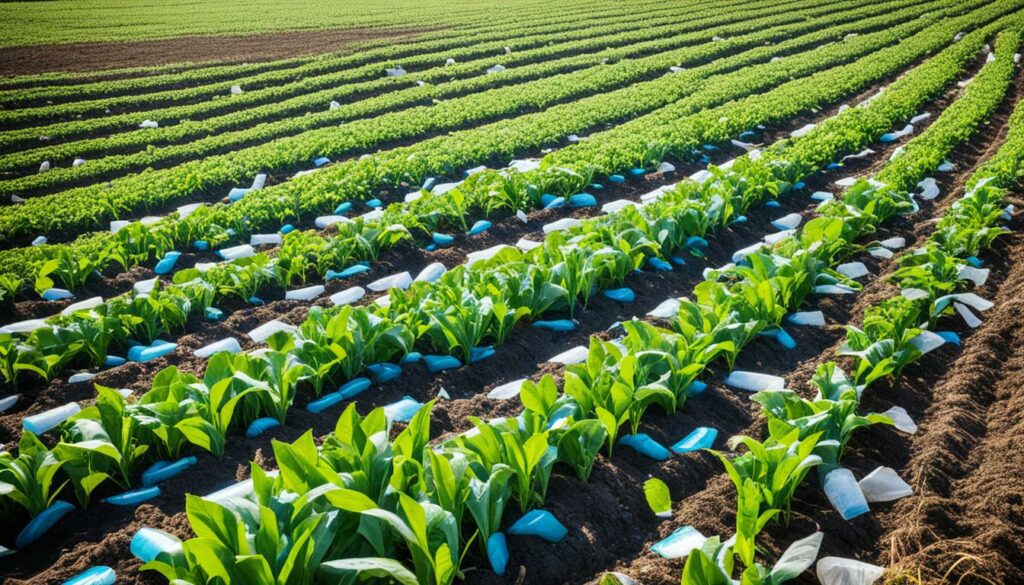
Microplastics going into the soil is one big issue. A large part of agricultural plastics is plastic mulch films. They can help by controlling weeds and pests. However, when they break down, they make the soil less healthy. Microplastics mess with the soil and its ability to grow crops right. This is a big challenge for farmers.
Microplastics don’t just stay in the soil. They also get into our water. Plastics used in farming can wash into rivers and lakes. Plastic mulch films, used a lot, cause about 120 pounds of waste per acre. This harms the water that animals and plants need. Also, these toxins can end up in our food. This is not good for our health.
Plastic waste also affects how well crops grow and their quality. In China, for example, plastic mulch films are really important. They save a lot of land. But, they can cause problems too. They might make chemicals build up and the soil too hot. This can make crops not as good. Plastic use in farming is a hard topic to balance.
The problems from plastic waste in farming are not simple. They’re about soil and water health and how much food we can grow. In the future, these issues might get worse. We need to find ways to fix these problems now.
Agriculture makes a big part of the world’s plastic waste. It causes about 26% of the yearly greenhouse gas emissions. Governments are making more laws to fight this. They are banning items like single-use plastics and making recycling rules strict.
Things like plastic mulch films, greenhouse covers, and irrigation tubing are under serious watch now. Every year, around 12.5 million tons of single-use plastics are used. Plastic mulch films make up half of that amount. The idea behind laws is to stop or cut down the use of these plastics. Places like the European Union and some Asian countries are leading the way. Take China, for example. They’ve saved nearly 4 million hectares of land by using less mulch film. It proves that handling plastic waste well is crucial.
Recycling is key in the battle against plastic waste in farming. Things like empty pesticide containers can be harmful if not handled properly. That’s why turning them into something useful is so important. Not only does proper recycling help the environment, but it also benefits farms. Waste can be turned into renewable energy through processes like anaerobic digestion. This supports farming that cares about the planet.
Meeting the plastic waste laws is not easy for farmers, especially the smaller ones. They often have small budgets and not enough space for waste. However, following these laws is a must. It means changing the way farming is done to use less plastic. Plus, this can also help reduce the amount of food that goes to waste. This food waste causes 8% of the world’s greenhouse gas emissions.
Global plastic production is on the rise, leading to a surge in single-use plastics waste. This waste has reached alarming levels, making it essential for international policies to tackle the issue. The UN Plastic Treaty, the EU Green Deal, and the US EPA National Strategy on Plastic Pollution are key initiatives. They aim to push for sustainable farming practices and reduce the negative effects of plastic pollution.
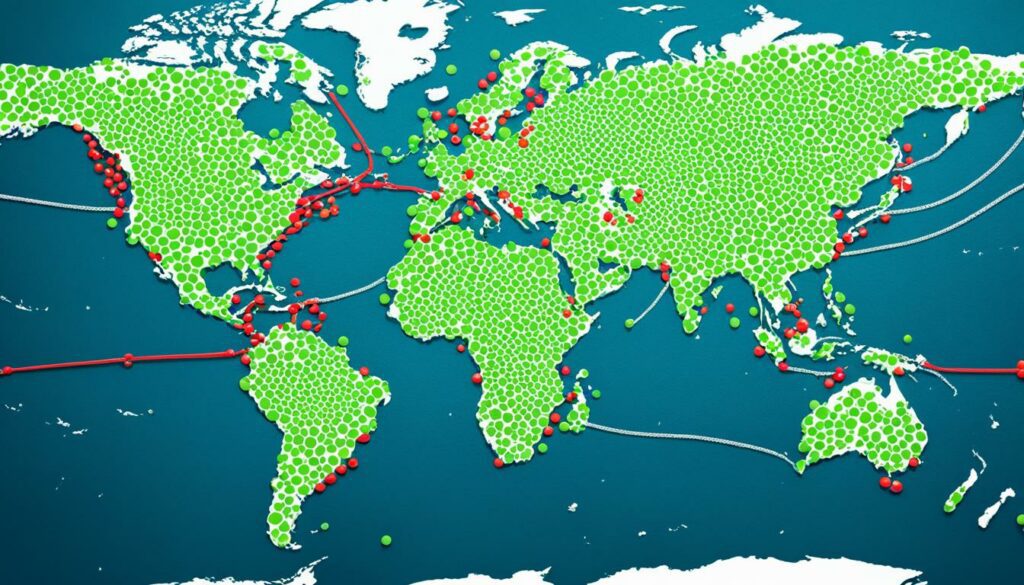
The UN Plastic Treaty is an important agreement. It commits nations to lessen plastic pollution by controlling plastic production and improving waste management. However, current efforts have only dropped marine plastic pollution by 7%. This shows the urgent need for better strategies and rules on handling plastic waste in farms.
The EU Green Deal is a major part of Europe’s fight against plastic waste, focusing on the farming sector. It aims to move towards a circular economy through recycling and reusing materials, reducing plastic waste. This policy is key in making Europe the first climate-neutral continent. It deals with the issue of single-use plastics effectively through strict rules and new recycling methods.
In the US, the US EPA National Strategy on Plastic Pollution aims to introduce strong policies to cut down plastic waste. This plan follows global standards, promoting sustainable farming to tackle the increasing plastic waste issue. It focuses on cutting back on plastic use, boosting recycling, and supporting green alternatives for farming. All this is to maintain the health of our planet.
In today’s world, using sustainable farming and reducing plastic waste is crucial. Farming plays a big part in harming our environment. It causes almost a third of the world’s greenhouse gases and uses a lot of energy and land. Every year, farmers use about 12.5 million tonnes of plastic, especially in things like mulch films. But now, we’re finding ways to farm better with less plastic, helping both our farms and nature.
Plastic mulch films make up half of the plastic used in farming. They help crops grow better. Without these films, China would need almost 4 million more hectares of land to grow enough food. But, too much plastic in farming can hurt the soil and the tiny organisms that help it. Farmers need to start using less plastic and finding cleaner, better ways to farm.
We need to do much better at dealing with plastic waste from farms. Right now, we hardly recycle any of it, so most of it just fills up landfills and harms the environment. But we can change this by using materials that break down naturally. This is why we should use materials that some back to the earth. Things like paper and compostable plastics are a good choice. They remind us to use the same materials again and again.
By treating plant waste without air (anaerobic digestion), we make the soil healthier and keep it full of important nutrients. This way, not only do we use less plastic, we also cut down on harmful gases and keep our planet’s plants and animals safe.
Clearing up after using pesticides is important too. Empty containers should be washed carefully. This stops the harmful chemicals getting into our environment. Farmers have to follow special rules and use special equipment to do this safely. The Food and Agriculture Organisation (FAO) helps countries make rules about reducing plastic waste. It also recommends using plastics that don’t last forever when possible.
| Sustainability Practice | Impact |
|---|---|
| Biodegradable Mulch Films | Reduces soil contamination and enhances biodegradability |
| Anaerobic Digestion | Generates green energy and reduces carbon footprint |
| Recycling Organic Waste | Enriches soil with nutrients, improving fertility |
Switching to better farming and less plastic is key for our planet. These new ways help farming become friendlier to the earth. They cut down the need for plastic. This way, we build a farming system that will last and take care of our home.
Rules for dealing with plastic waste in farming are getting stricter. This is to cut down on the bad effects of plastic getting into the environment and hurting us and nature. Farming makes up almost a third of the gases that cause climate change and uses up a lot of water. The amount of plastic in farming has gone up in the past 70 years to about 12.5 million tons yearly. Half of all farm plastic is plastic film for mulching.
In 2019, farms used 12.5 million tonnes of plastic for growing plants and animals. They also used 37.3 million tonnes of plastic for wrapping food. People all over the world are taking action to deal with the plastic problem. For example, 175 countries agreed in March 2022 to work on a new law about plastics. These steps are part of a bigger effort around the world to handle plastic without hurting the planet.
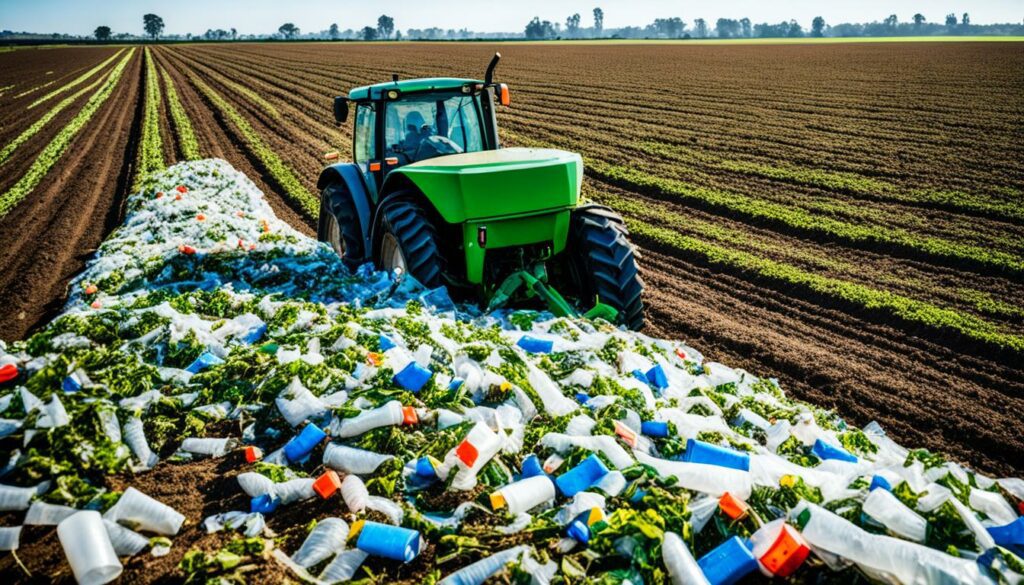
China is dealing with these rules in a big way. Without plastic film, they would need a lot more land to grow food. So, plastics are really important for farming today. But, it’s crucial to use them right to protect the environment. Rules in China also encourage farmers to use plastic that doesn’t harm the planet, following good farming and circular economy ideas.
The FAO helps countries use farm plastic better through different projects. A project called GEF FARM helps reduce and manage chemicals in farming. Also, the GloLitter Partnerships help poor countries keep their beaches clean. They’re working on a set of rules for using plastic smartly in farming, set up by the FAO.
It’s urgent to do something because most plastic used on farms is not being reused. It ends up in the ground or taken to landfill, which isn’t good for the earth or our food. The FAO is pushing for strong and smart rules about plastic in farming to solve these problems. They aim for farming to be kinder to the planet.
In the UK, most land is used for farming. The Environment Agency (EA) has seen more and more plastic waste being sent away illegally. The punishments for this are very serious. But, the EA is not only stopping this, they are also teaching farmers how to handle their waste well. They’re working with students, too, to make sure everyone knows how to take care of the environment.
The need for films used in farming will go up by half in the next ten years. This shows we must work on using plastic better in farming. We have to make stronger rules and teach people how to farm in a way that’s good for nature.
Plastic waste in agriculture is a big issue now. Every year, the world uses 12.5 million tons of plastic. It has become crucial to find ways to handle this waste, especially in the farming sector.
Plastic mulch films are a major part of agriculture’s plastic use. They help with controlling weeds and pests, save water, keep soil at the right temperature, and boost plant growth. Without mulch films, China would need much more land to grow the same crops.
Global efforts are working to tackle plastic waste. Europe and Asia lead in plastic film use, with 40–50 kg per hectare. In comparison, the Americas use 10–20 kg per hectare. Sticking to plastic films that break down naturally is a big strategy in going greener.
Covering greenhouses with plastic sheets and adding plastics to fertilizers help farming. Japan, for example, uses a lot of these coated fertilizers. Yet, most plastic waste is not collected, causing harm to Nature. So, we need better ways to deal with this waste.
The report underscores the necessity for countries to adopt a range of strategies tailored to their national circumstances, infrastructure capacities, and available resources.
Policy insights advise things like making producers responsible for their products, having places to return plastic for money back, and working with waste pickers. We need many steps, including making new rules and building better systems, to fix the plastic problem.
| Region | Plastic Mulch Film Use (kg/ha) |
|---|---|
| Europe and Asia | 40-50 |
| North and South America | 10-20 |
We must look at each place’s unique situation to find the best way to manage plastic waste. Following global plans and making local laws is key to stop plastic pollution in farming effectively and for good.
Dealing with plastic waste laws is tough for everyone. Farmers, businesses, and governments find it hard. They need to deal with money issues, not knowing enough, and technology problems. These are all needed to follow strict environment rules made by the world.
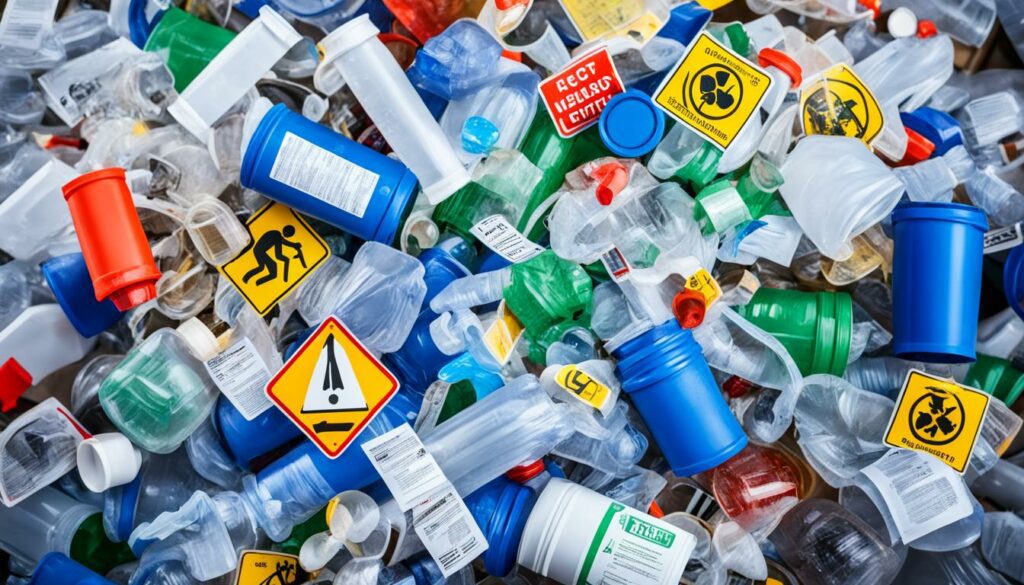
Managing plastic waste costs a lot, causing big issues for many businesses. Even if they want to follow the rules, it’s difficult due to the costs. In the European Union, for example, the price to recycle and manage waste properly is huge. This is especially hard for businesses in poorer countries who might not have enough money. They find it tough to spend money on new technology and systems.
Many people don’t know enough about how to handle plastic waste properly. This lack of understanding is a big challenge, especially in the countryside and poorer areas. For instance, many don’t know the effect of a type of plastic called thermoplastic resins. Overcoming these knowledge gaps is crucial to follow the environmental rules well.
There are not enough good technologies to deal with all the plastic waste. Despite a big increase in plastic, recycling technologies have not advanced enough. Less than 20 percent of plastics are recycled worldwide. This shows the urgent need for better recycling and waste treatment methods. With a huge amount of plastic being made each year, we must find better and cheaper technology solutions.
Following plastic waste rules is a big challenge. Tackling money issues, educating everyone, and improving technology are crucial. These steps help not just businesses but also make our world a better place to live in.
The European Union is tackling the big problem of plastic waste in farming in lots of ways. They’ve launched the EU Green Deal to cut down on plastic use in farming activities. This move aims to make a significant decrease in the use of plastic on farms.
In 2022, Europe saw the introduction of 713 kilotonnes of new plastic, with films making up 76% and only a tiny 1% being biodegradable. This huge amount of plastic leads to over 1,100 KT of waste. This waste includes 708 KT of plastic with soil and other residues from farming.
The EU is working hard on recycling and managing waste better. Making plastic ready for recycling starts at the farm with sorting, cleaning, and turning it into new plastic granules. These granules are then used to make brand-new plastic products.
Most of the extra waste from farm plastic, about two-thirds, comes from growing veggies. The rest, about one-third, comes from raising animals. Vegetable farming can create a lot more plastic waste compared to farms raising animals. This difference is because vegetables often need more protection.
| Category | Plastic Use (KT) | Waste Generated (KT) |
|---|---|---|
| New Plastics on Market | 713 | 708 |
| Animal Production | 237 | 396 |
| Vegetable Production | 476 | 779 |
The costs of dealing with this waste are very high, from the farm to the final disposal. The EU is pushing to cut down on packaging waste by 5% by 2030, and by 15% by 2040. They want all packaging in the EU to be recyclable by 2030.
The EU Green Deal is more than just using less plastic. It’s about moving towards a circular economy. This means reusing and recycling resources to create less waste. This approach fits with the EU’s wider goal of caring for the environment and using resources wisely.
The United States is actively tackling the issue of plastic pollution in agriculture. The US EPA crafted a National Strategy on Plastic Pollution farming. This plan aims to cut down plastic waste by focusing on recycling, improving product designs, and educating communities.
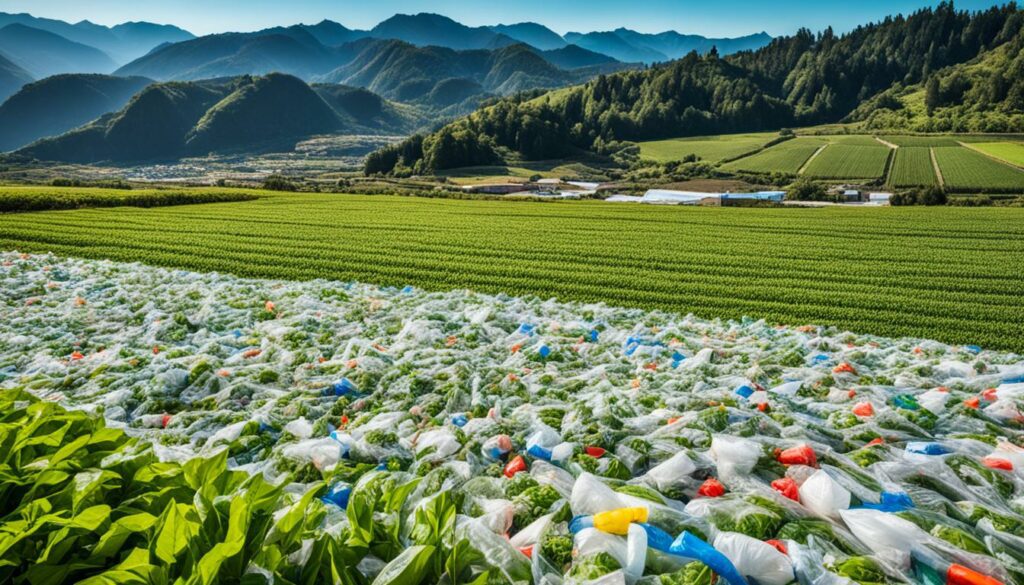
Plastics have become a big problem in farming, reaching 12.5 million tons yearly over the past 70 years. One key goal is to boost the US’s recycling rate to 50 percent by 2030. This big aim gets support from the Department of Energy, which aims to cut greenhouse gases by half.
The USDA plays a crucial part too, leading the charge in creating bioplastics from crop sugars. The idea is to produce plastics that are better for the environment. Also, USDA organic rules encourage using plastic mulches that are at least 80% from bio sources. This fits into the wider plan to reduce plastic waste in farming.
Globally, the US steps up by joining groups like the Global Ghost Gear Initiative (GGGI). It got more than $1.5 million to help clean up marine trash, including ghost fishing gear, in the Caribbean. These global efforts show the US is serious about managing plastic waste.
Here’s a detailed look at how key players are working to reduce plastic waste:
| Agency | Initiatives | Impact |
|---|---|---|
| US EPA | National Strategy on Plastic Pollution farming | 50% recycling rate by 2030 |
| Department of Energy | GHG reduction solutions | Reduce emissions by 50% |
| USDA | Bioplastics R&D | Sustainable nylon plastics |
| FDA | Recycled plastics in food | Safe usage reaffirmation |
| USFWS | Marine debris removal | 950 metric tons removed |
The US focuses not only on laws but also on teaching farmers how to follow them and use best farming practices. Despite the challenge of plastic waste, the US is heading towards a greener and more eco-friendly future in farming.
China’s way of dealing with plastic waste has had a huge impact worldwide. In 2017, it stopped taking in plastic from other countries. This big change made the world rethink how it handles plastic waste and made many countries improve their recycling.
In 2021, China made 80.1 million tons of plastic. Even with its high production, it made smart moves. For example, it stopped using new plastic bags so much, reducing their use by almost half. These steps showed real progress in making recycling better overall.
By 2019, China was making nearly a third of the world’s plastic, around 95.7 million metric tons. Most of this, about 60%, went into making items we use once and throw away. While the plastic production soared, only 30% of the waste plastic got recycled.
China is working hard to manage its plastic pollution. But, efforts are still needed in some areas like cutting down on making new plastic. Policies now focus on cutting the use of plastic packaging, disposable items, and straws. There are also new taxes to encourage less pollution from plastic.
Until 2019, China was bringing in lots of synthetic resins, about 33.7 million tons. It sent out much less, just 6.5 million tons. This shows China depended a lot on these materials. The ban on used plastic imports changed the global waste plastic trade a lot. China was a major player, handling almost 60% of this trade before.
China’s choices on dealing with plastic waste are shaping how the world manages this issue. Countries everywhere are now working harder to deal with their plastic waste at home. This shows how important China is in creating better global plastic waste management.
Technology has greatly changed how we handle plastic waste in farming. The advancement of recycling technologies is key in dealing with the 12.5 million tons of plastic used every year in agriculture. These advances help process plastic waste better and turn it into materials we can use again, which supports a circular economy.

Advanced recycling technologies have been created for farming plastics like mulch films. These films take up around 50% of all plastic used in farming. In places like Europe and Asia, they are used more, about 40-50 kg/ha, while the Americas use less, around 10-20 kg/ha. This difference in use shows how important it is to find good recycling solutions to lessen our environmental impact.
Technology in recycling agricultural plastics has big effects on the world’s economy and environment. For example, China would need 3.9 million more hectares of land without mulch film to make the same amount of food. This points out how crucial technology is for boosting farm output and saving land.
Japan’s use of 2.3 million tons of special fertilizers from 1976 to 2018 highlights how tech in farming can cut down on emissions by making nitrogen use more efficient. This not only ups productivity but also meets environmental goals set by 175 nations in March 2022 with the Plastics Treaty.
With plastic waste increasing from 0.35 million tonnes in 1950 to over 360 million tonnes in 2018, technology is more important than ever for waste management. About 60% of plastic becomes waste, which urges us to find better ways for recycling and using biodegradable options.
The future of managing plastic waste largely depends on tech progress. Moving forward, we aim to create methods that are good for our pockets and the planet. These methods will turn waste into useful resources, ensuring a sustainable future for our lands and more.
The world’s approach to global plastic waste regulations farming is complex. Many laws and actions aim to use less plastic, support eco-friendly farming, and protect nature. In the last 70 years, farming’s plastic use has skyrocketed to about 12.5 million tonnes yearly. Mulch films, for example, make up half of this amount. They help crops grow better, use less water and nutrients, need less pesticide, and keep soil moist.
Plastic mulch film use is highest in Europe and Asia, using 40-50 kg per hectare. In North and South America, it’s lower at 10-20 kg per hectare. In China, using these films has made farming more efficient. It’s helped avoid using an extra 3.9 million hectares of farmland. Also, making nitrogen fertilizers add up to 5% of the world’s greenhouse gases.
From 1976 to 2018, Japan used 2.3 million tonnes of special fertilizers. These fertilizers help crops use nitrogen better. This shows how rules about plastic waste in farming matter for our health and the environment. In March 2022, 175 countries agreed to work on a global plastic treaty. Their goal is to stop plastic pollution by 2024. This shows how big the plastic problem is.
But, more plastic also means big problems. In 2019, agriculture used 12.5 million tonnes of plastic for growing things and 37.3 million tonnes for food packages. The need for greenhouses, mulching, and silage plastic films might go up 50% by 2030. Sadly, very little of this plastic gets recycled. Most is thrown away, harming nature and people.
The Food and Agriculture Organization (FAO) works to help manage farm plastics. They support efforts like the GEF FARM project to deal with this issue. The FAO is helping to make laws against plastic pollution. They’re also making a guide for using plastic in farming in a better way.
These efforts show how working together is important. Everyone, from governments to farmers, must join forces. This is to make and follow through with good plans about plastic use on farms. Collaboration is key to make real change.
In agriculture, we expect to see stronger rules on plastic waste. This is to tackle the big problem of too much plastic in farming. One big step is to use more materials that break down naturally, like certified biodegradable mulch films. These films break down into things like carbon dioxide, so they’re better for the planet than regular plastic films.
Right now, plastic mulch films make up half of all plastic used in farming. They’re good because they help with keeping weeds and pests away, save water, and make plants use nutrients better. But, these plastic films are bad for the environment. So, soon, there will be harder rules on how to use and throw away these films. This will especially be true in places that use a lot of these films, like Europe and Asia.
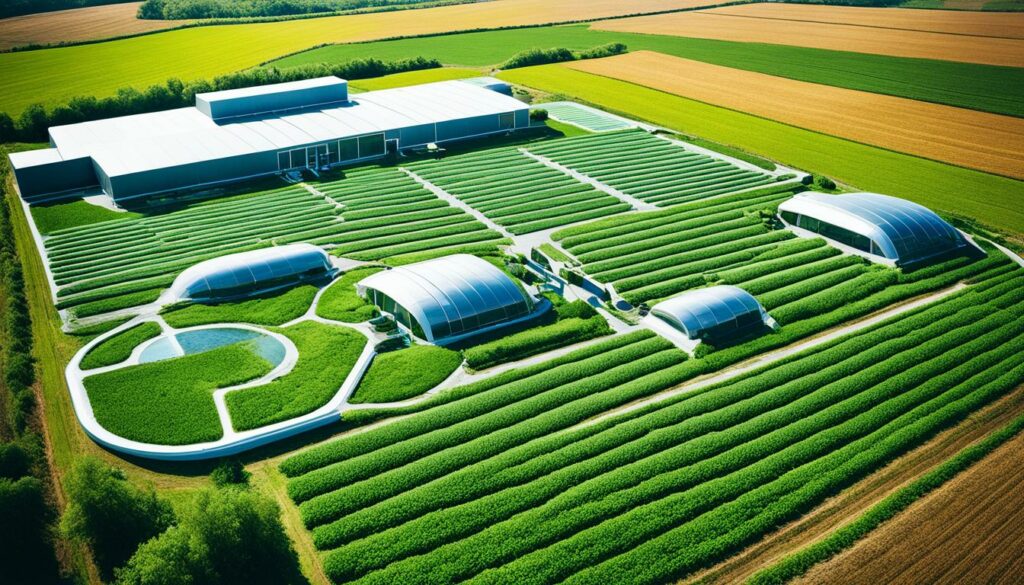
With more and more plastic in farming, we need everyone involved to come up with ways to recycle or reuse it. This includes plastic makers, farmers, and people who handle waste. Working together is key to stop plastic from harming our soil and water. The FARM program is a great example of this, stopping large amounts of harmful substances and plastic waste from entering the environment every year.
Across the world, we see countries offering money to farmers who use less harmful chemicals. This year, many countries put together almost $380 million to fight pollution from chemicals and plastic in farming. Soon, it will be really important for farmers to do things in a way that’s good for the earth. This will help farming to be more circular, meaning everything is used wisely again and again.
To see how laws are influencing plastic use in farming, let’s look at some global facts:
| Region | Plastic Mulch Film Usage (kg/ha) | Arable Land Needed Without Mulch Film (hectares) |
|---|---|---|
| Europe | 40–50 | Not Specified |
| Asia | 40–50 | 3.9 million (China) |
| North America | 10–20 | Not Specified |
| South America | 10–20 | Not Specified |
It’s clear that we need strict rules and smart strategies to manage plastic waste in farms. These steps are crucial for the health of our planet and for farming to be truly sustainable.
We face a big issue with plastic use growing faster than our efforts to stop it. Despite our work, only a 7% drop in plastic in the sea is expected. This shows we need urgent, strong measures worldwide.
The push for a global law on plastic started after UNEA5 in 2022. Big players like the EU and China are working together to change how we use plastic. This change is hard because plastic production has more than doubled since 2000.
In 2019, the world recycled just 9% of its plastic waste. Nearly half went to landfills. Also, 22 million tonnes of plastic go into the environment each year. This causes big risks to our health and the planet.
To fight this, we need to start using plastic in better ways. We must invest a lot of money in stopping plastic from hurting the environment. Especially in places that can’t afford to do this yet.
Everyone, from governments to businesses to you at home, must work together. We need to use new ways to recycle and better rules. This way, we can really cut down on plastic pollution. It’s all about making sure we look after the Earth for those who come after us.
The UN Plastic Treaty, the EU Green Deal, and the US EPA’s National Strategy on Plastic Pollution are vital. They push for sustainable farming and reduce single-use plastic. These efforts aim to cut down on plastic pollution in farming.
Plastic waste harms farming. It puts microplastics in the soil and water. This lowers crops’ quality and yield. Plus, it can affect people’s health by entering the food chain.
Many places are banning or limiting single-use plastics in farming. These are part of bigger plans to reduce plastic waste and farm sustainably.
The UN Plastic Treaty wants to globally tackle plastic pollution. It asks countries to cut plastic use and improve waste management. The goal is to protect the environment from plastic harm.
The EU Green Deal aims high in fighting plastic waste. It will tax plastics and boost recycling. It wants to make agriculture use less plastic and be more sustainable.
The US EPA’s plan targets plastic waste in farming. It wants better waste management and more recycling. It’s also looking into eco-friendly materials to replace plastic.
To cut down on plastic, farmers can use biodegradable materials. They should also manage waste better. And adopting circular economy principles helps reduce plastic use.
There are challenges like cost and a lack of resources. Technology might also be a barrier. These things can make it hard for farmers to follow the rules and be sustainable.
Tech is offering new ways to recycle and biodegradable options. These new methods aim to be cheaper and better ways to handle plastic waste in farming.